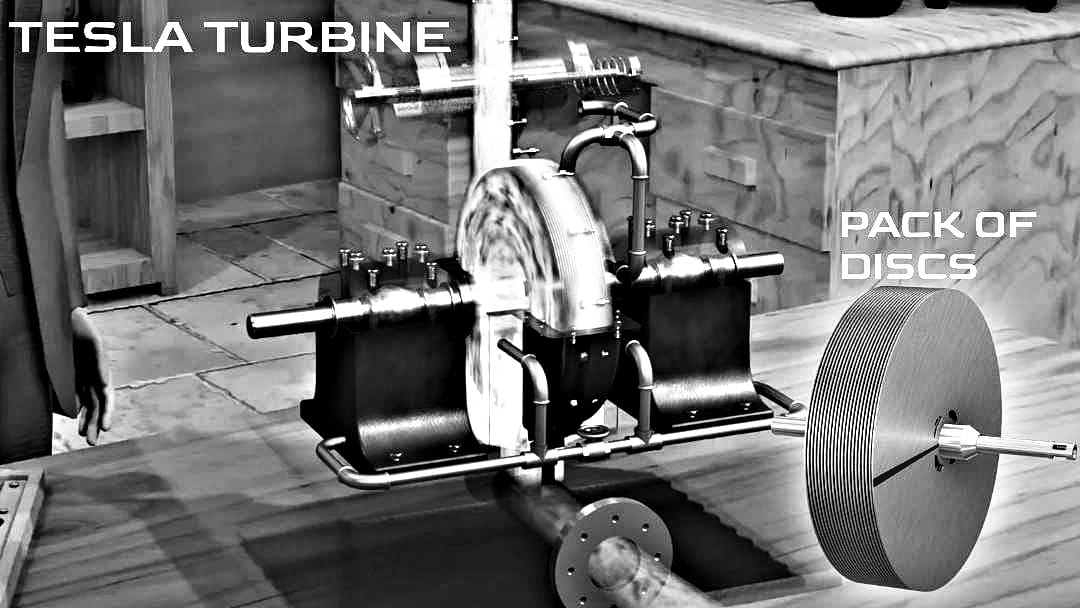Establishing National
Standards for Power Engineers.
Innovation and Engineering Excellence

The Genius of Tesla’s Bladeless Turbine: A Lesson in Innovation and Engineering Excellence
Nikola Tesla, one of the most brilliant minds in the history of engineering, redefined the concept of energy generation with his innovative bladeless turbine. This groundbreaking invention, which harnesses the power of fluid adhesion, offers valuable lessons for today's power engineers and serves as a reminder of the endless possibilities in our field.
Understanding the Boundary Layer Effect
At the heart of Tesla’s turbine is the boundary layer effect—a principle that describes how fluids behave when they flow over a surface. Unlike traditional turbines that rely on blades to convert fluid energy into mechanical power, Tesla’s design uses a series of smooth, flat disks. When a fluid, such as steam or air, flows between these disks, it adheres to their surfaces, transferring its kinetic energy as it spirals inward. This innovative approach allows for a gradual and efficient conversion of energy, minimizing the losses typically associated with turbulence and friction.

Simplicity and Durability: The Hallmarks of Tesla’s Design
One of the most remarkable aspects of Tesla’s turbine is its simplicity. By eliminating the need for blades, Tesla reduced the number of moving parts, making the turbine more durable and easier to maintain. This focus on simplicity is a lesson for modern engineers: sometimes, the most effective solutions are those that streamline and simplify complex processes.
Tesla’s own words from his 1913 patent capture the essence of his invention: "The working fluid, as steam or gas, is directed against the disks at a very small angle so that its velocity is gradually reduced by fluid friction and adhesion to the disks. The main object of my invention is to secure this gradual reduction of the velocity and to thereby convert the largest possible part of the energy of the motive fluid into mechanical power."
Implications for Modern Power Engineering
While Tesla’s turbine did not gain widespread adoption during his lifetime, largely due to the dominance of traditional designs and the manufacturing challenges of the era, its principles continue to inspire innovation. For today’s power engineers, Tesla’s work is a powerful reminder of the importance of thinking outside the box and challenging established norms.
American Society of Power Engineers (ASOPE®) is committed to fostering this spirit of innovation. Whether you are just beginning your career or looking to advance to the next level, ASOPE® offers a range of resources, programs, and certification exams designed to help you excel. By understanding the principles behind groundbreaking technologies like Tesla’s turbine, you can enhance your expertise and contribute to the future of power engineering.
Explore ASOPE® Resources
We invite you to explore the educational opportunities available through ASOPE®. Our certification programs are designed to equip you with the knowledge and skills needed to lead in today’s rapidly evolving energy sector. Whether you’re interested in the theoretical aspects of power engineering or hands-on applications, ASOPE® provides the tools you need to succeed.

The Genius of Tesla’s Bladeless Turbine: A Lesson in Innovation and Engineering Excellence
Nikola Tesla, one of the most brilliant minds in the history of engineering, redefined the concept of energy generation with his innovative bladeless turbine. This groundbreaking invention, which harnesses the power of fluid adhesion, offers valuable lessons for today's power engineers and serves as a reminder of the endless possibilities in our field.
Understanding the Boundary Layer Effect
At the heart of Tesla’s turbine is the boundary layer effect—a principle that describes how fluids behave when they flow over a surface. Unlike traditional turbines that rely on blades to convert fluid energy into mechanical power, Tesla’s design uses a series of smooth, flat disks. When a fluid, such as steam or air, flows between these disks, it adheres to their surfaces, transferring its kinetic energy as it spirals inward. This innovative approach allows for a gradual and efficient conversion of energy, minimizing the losses typically associated with turbulence and friction.

Simplicity and Durability: The Hallmarks of Tesla’s Design
One of the most remarkable aspects of Tesla’s turbine is its simplicity. By eliminating the need for blades, Tesla reduced the number of moving parts, making the turbine more durable and easier to maintain. This focus on simplicity is a lesson for modern engineers: sometimes, the most effective solutions are those that streamline and simplify complex processes.
Tesla’s own words from his 1913 patent capture the essence of his invention: "The working fluid, as steam or gas, is directed against the disks at a very small angle so that its velocity is gradually reduced by fluid friction and adhesion to the disks. The main object of my invention is to secure this gradual reduction of the velocity and to thereby convert the largest possible part of the energy of the motive fluid into mechanical power."
Implications for Modern Power Engineering
While Tesla’s turbine did not gain widespread adoption during his lifetime, largely due to the dominance of traditional designs and the manufacturing challenges of the era, its principles continue to inspire innovation. For today’s power engineers, Tesla’s work is a powerful reminder of the importance of thinking outside the box and challenging established norms.
American Society of Power Engineers (ASOPE®) is committed to fostering this spirit of innovation. Whether you are just beginning your career or looking to advance to the next level, ASOPE® offers a range of resources, programs, and certification exams designed to help you excel. By understanding the principles behind groundbreaking technologies like Tesla’s turbine, you can enhance your expertise and contribute to the future of power engineering.
Explore ASOPE® Resources
We invite you to explore the educational opportunities available through ASOPE®. Our certification programs are designed to equip you with the knowledge and skills needed to lead in today’s rapidly evolving energy sector. Whether you’re interested in the theoretical aspects of power engineering or hands-on applications, ASOPE® provides the tools you need to succeed.

